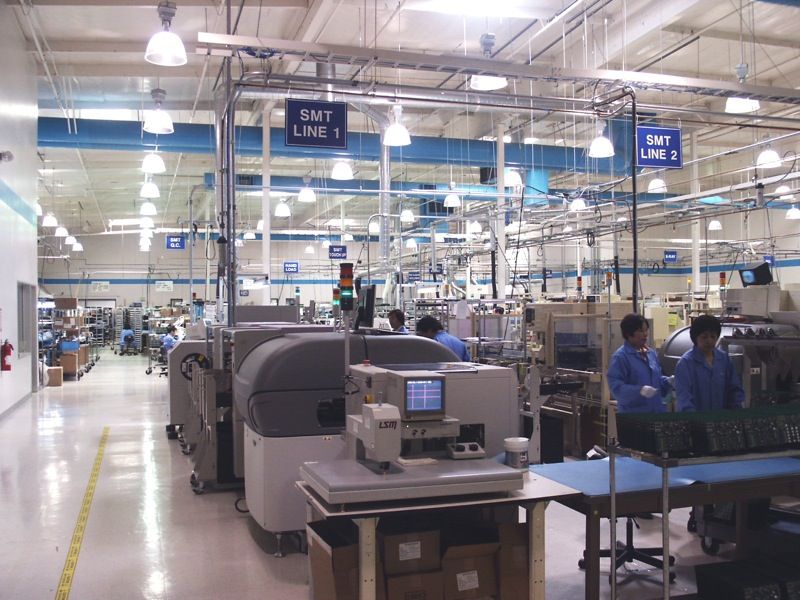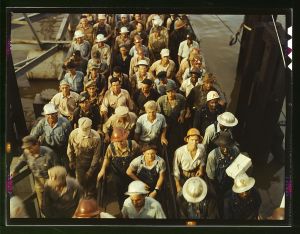
In his new book Making It: Why Manufacturing Still Matters, Louis Uchitelle argues that manufacturing should be a “subsidized activity with social obligations.” And he has a point. While we’re not at the height of American manufacturing power — that was 1979 — Uchitelle notes that the federal government is already subsidizing manufacturing. He argues it should be subsidizing it even more. In this wide-ranging interview Uchitelle illustrates the importance a strong manufacturing base has for American society in terms of education, economy and civil rights. You can read an excerpt from Making It here. BillMoyers.com producer Kristin Miller talked with Louis Uchitelle about why we still need a strong manufacturing base in the United States.
Kristin Miller: Why do you think the image of the factory worker still has so much resonance in our political culture, as we’ve just seen in the last election, when it’s not a reality for most people?

Workers leaving Pennsylvania shipyards, Beaumont, Texas; June 1943, Farm Security Administration (Library of Congress, John Vachon)
Louis Uchitelle: I think that historically there is a reason — we think we’re an industrial country, and if we do well industrially, then people somehow will be employed. In 1979, we hit a high point in manufacturing employment in the United States of about 19 million. That plummeted between 1979 and the late 1980s to about 10 million, and now it’s come back to about 12 million. If we increased manufacturing output as a share of the economy to what it should be — 17, 18, 19 percent, as it is in other industrial countries — that’s not going to generate a lot of new jobs. Maybe a couple million. In automated manufacturing, the era of high employment in factories is gone. Those images of thousands of workers streaming out of the factory at the change of a shift dating from World War II and the 1950s and even the 1960s, that’s gone.
KM: You’ve shown in your book that manufacturing actually subsidized greatly by government and local incentives. What do you think is our American problem with calling a subsidy a subsidy — even the Manufacturers Association avoids that term. Is it because we think of it as a handout and we hate that concept?
LU: I think we think of manufacturing as a free enterprise activity. The Soviet Union got to be a great important manufacturing country. They competed with us. We were the capitalists, so we insisted on soft-pedaling any mention of subsidies. Once the Cold War was over, it was easier for us to acknowledge that manufacturing by its very nature, forget ideology, going back a couple of centuries to its origins, has always been a publicly subsidized market activity. It’s just too complicated an undertaking to do without that public support and it’s too important to the economy. So we have developed a series of subsidies. A lot of it is done locally. A lot of manufacturing, close to 20 percent, is weapons manufacturing sold to the Defense Department. That’s a big chunk, maybe approaching $200 billion.
So we have a situation where the public money comes to around $600 billion or more, a bit more, out of $2 trillion in value added. That is, where you take a sheet of steel that’s worth $100 and stamp it into a fender worth $125. The value added is $25. When you take a steel tube and shape it into a rifle barrel, you add value. And that added value is how we measure manufacturing output. When I started writing this book a couple of years ago, we were the largest manufacturer in the world, our output measured as value added. We have now fallen behind China and Korea. Other Asian countries, not to mention the European Union, are leaving us behind as manufacturing powerhouses. In that sense, it’s essential to understand the nature of manufacturing if we’re to sustain our role in it. (Learn more about how we and other countries subsidize manufacturing in an excerpt from Making It).
KM: Do you think there’s any way to counter the sort of exclusionary definition of skill between white-collar and blue-collar workers? Can you explain a little what the difference is between a “skills shortage” and a “skills surplus,” and why it matters?
LU: Well, in my book, I try to undercut that whole idea of “skilled.” In white-collar work and blue-collar work you can learn a skill on the job. It doesn’t require a college education. Skill should be thought of in this country as something that’s learned on the job. If you need any skilled worker, you can usually train that person on the job or through an apprenticeship in a year or much less. So when we say there’s a skills shortage, that just isn’t true. We’ve used that skills shortage idea to explain why we don’t have more manufacturing in this country. When you hear people talk about the need for more education because there isn’t enough work going around out there; they’re saying wrongly we’ll need to ration it by raising the education bar.
KM:Do you think we can ever rebuild the strength of unions?
LU: I would like to. I think that unions are a necessary institution in this country, both as a force to retain manufacturing and as a necessary organization in the distribution of the added value generated by manufacturing. Manufacturing generates a lot of value added that can be split between owners and labor. I don’t see the unions coming back. I mean the old industrial unions, which did wonders in bargaining a decent share of value added for workers.
KM: I was really fascinated by your take that the death of urban manufacturing has a civil rights angle. Can you talk a little bit more about that?
LU: I didn’t expect to find that when I started out doing this book, but I felt I had to do a chapter on urban manufacturing and the exodus of manufacturers from urban sites. We were always citing the cost, the lack of transportation, all sorts of things as to why manufacturing had disappeared from the center of town. What happened was that as manufacturing left the cities — often for good reason; they were in multistory buildings in the cities and modern manufacturing requires single-story, large, hanger-like buildings. As they moved out, they left behind a huge sector of the population that couldn’t follow them.
For example, General Motors closed its factory in North St. Louis, which was an inefficient multistory factory, [and] reopened in Wentzville, a modern factory, about 80 miles away. Now when a young person rolls out of high school and has no desire to go to college and needs a good job that earns well, there isn’t a factory for that person to enter as an employee. And that’s a loss, because, again, manufacturing adds a lot of value to products and it lends itself to union organizations who can then organize workers and bargain for a reasonable share of that output. You’re leaving behind not only this generation of African-American workers, but the next and the one after that who have to leave town if they want to find a decent job. They won’t find it in manufacturing. And manufacturing has been a huge source of employment for African-Americans. I think we need a civil rights movement to make clear that we need manufacturing because it offers high-wage employment. We need it in cities because that’s where a lot of African-American communities are and the young people can’t just leave.
KM: So you think that we’ll ever get to the idea that manufacturing should be, as you say, a subsidized activity with social obligations? Do Americans really understand how dependent “American-made” is already on subsidies and foreign products?
LU: First we have to acknowledge that it is a subsidized activity. We as Americans don’t really understand how dependent we are on foreign tools and foreign parts when we say something’s made in America. We don’t understand that we can’t be a service economy only — we have to have a certain level of manufacturing. We’ve talked ourselves into the idea that we could be service people, but you can’t trade services for the physical manufactured goods that you need. You have to make in America our share of those goods. Unfortunately, we have a system of multinational companies, all of them excellent manufacturers. They dominate manufacturing in this country. They do it very well. But they make in China or some other country what they sell in those countries, and there should be more exported from here.
Now, that’s not an easy thing to impose. You have to sit down and bang heads with people in Asia, people in Europe and work out how much will be made in the United States and exported and how much made overseas. But that’s the debate that should be going on all the time.
KM: Do you think that any of Trump’s free trade policies are going to help or hurt this negotiation?
LU: I think he won the election partly because of the angst that exists because of some of the problems that I’m discussing. But I don’t see him coming up with anything that even begins to address what I’m describing. He hasn’t turned around and said, “Here’s a truly viable solution.”
KM: Did you feel like, when you were writing this book, that you were sort of documenting the end of the American dream?
LU: No, I didn’t feel that. I didn’t think about the American dream. If anything, the American dream probably ended with my parents and your parents. But to the extent that there is an American dream — I think the American dream is always there. We’re always hopeful of doing something better. But we’ve certainly documented the end of high-earning jobs for high school-educated people who could go into factories and earn well, particularly if they were unionized, without a college education. Which is all right. That’s the nature of automation. So if we want to employ people en masse, we probably have to do it elsewhere, and I would say infrastructure — that is, a high-speed rail line between New York and LA or San Francisco — would employ a lot of people. That would be something that I think Trump talked about before he was elected. I haven’t heard a word since.



